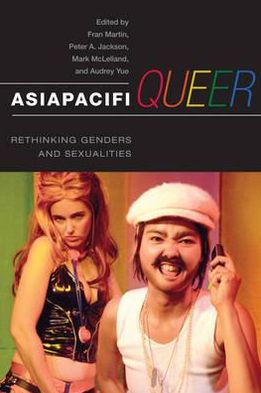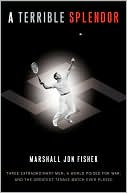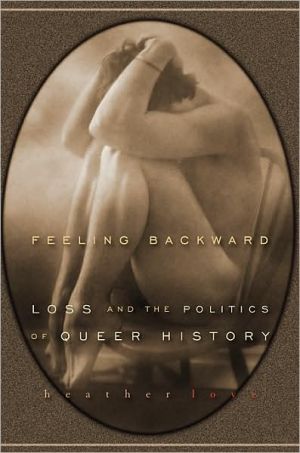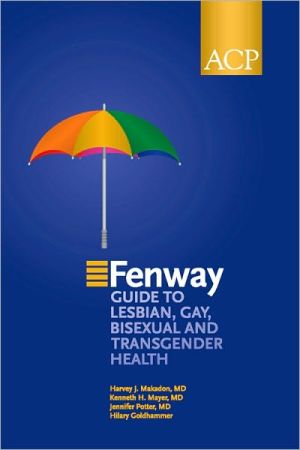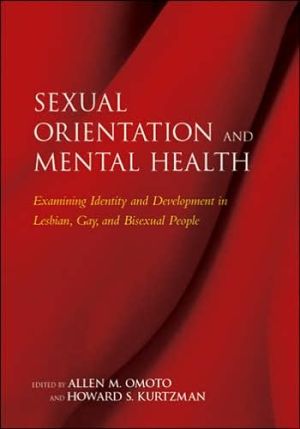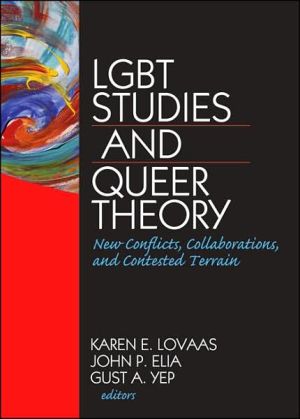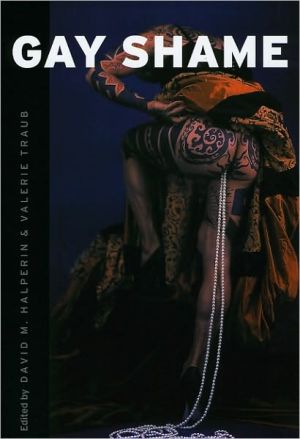AsiaPacifQueer: Rethinking Genders and Sexualities
This interdisciplinary collection examines the shaping of local sexual cultures in the Asian Pacific region in order to move beyond definitions and understandings of sexuality that rely on Western assumptions. The diverse studies in AsiaPacifiQueer demonstrate convincingly that in the realm of sexualities, globalization results in creative and cultural admixture rather than a unilateral imposition of the western values and forms of sexual culture. These essays range across the Pacific Rim and...
Search in google:
A multidisciplinary, multicultural reassessment of gender and sexuality in the Asian Pacific.
ASIAPACIFIQUEER\ Rethinking Genders and Sexualities \ \ University of Illinois Press\ Copyright © 2008 Board of Trustees of the University of Illinois\ All right reserved.\ ISBN: 978-0-252-07507-0 \ \ \ Chapter One\ EMBODIED MASCULINITIES OF MALE-MALE DESIRE \ The Homo Magazines and White-Collar Manliness in Early 1970s Japan\ J. Darren Mackintosh\ The Homo Magazines of the Early 1970s: A "Failure"?\ The first specialized, commercially marketed, professionally produced, and nationally distributed magazines catering exclusively to men who loved men—or homo, as these magazines' readers were called—appeared in the early 1970s in Japan. Starting with the publication of Rose Tribes (Barazoku) in 1971 and followed in quick succession by The Adonis Boy (1972), Adon (1974), and Sabu (1974), the homo magazines featured an eclectic mix of essays on male-male eroticism, lifestyle columns on Japan's popular and homo cultures, pornography, and regular readers' contributions sections, the most important of which were the personal columns where men sought contact with other men.\ All of these items had been seen before. In the two decades following the Allied occupation of Japan (1945–52) to the early 1970s, publications catering to male-male sexuality generally took two forms. There were the "common interest journals" (dojinshi) of a variety of unrelated private members' clubs organized by and for men who love men, which were made up of members' literary and/or artistic contributions. There also was a genre of "erotica magazine" (fuzoku zasshi) that treated male-male sexuality in feature sections as one of an array of male-female and male-male sexual desires. Because of the dispersed nature of this publication activity, the culture of male same-sex love was fleeting in its visibility for many. Moreover, its representation, created by a disparate range of authors and artists, was atomized and eclectic, reflecting the wide spectrum of male-male sexual performances, practices, understandings, and concepts that characterized the early- to mid-postwar era (1950s-1970s) ranging from the "transgendered" (gei) to the hypermasculine.\ Barazoku challenged this situation when it first hit the bookstands in 1971. Marketed in mainstream bookshops, it broke the barrier separating main-stream society from its underground to bring the largely hidden world of homo into the public gaze. Moreover, the visibility was to be sustained since the magazine would appear regularly (published every other month after its launch and monthly from 1974). Homo desire could now be explored in a venue that was accessible to anybody across the nation. As a result, the atomization characterizing previous decades was potentially eclipsed, if momentarily. Barazoku and the magazine genre it generated were a success, expanding and enduring to help define the culture of male-male sexuality in Japan in the last quarter of the twentieth century.\ Despite their relative success and longevity, the significance of the homo magazines to the postwar history of male-male sexuality has been judged by some as doubtful. Ethnographer Wim Lunsing, for example, suggests that the influence magazines like Barazoku had on fostering lasting gay networks and stimulating gay political activity was limited at best. Writer Nokami Teruki is more ambivalent on the ability of the magazines to raise sociopolitical awareness, arguing that they were undermined by their close association with the commodified sexual world of bars, sex clubs, and cruising areas that had emerged in postwar Japan's major cities. Gay activist Minami Teishir is the most critical, asserting that the homo media activity of the early 1970s and especially Barazoku (the vanguard publication) all failed to incite the homo voice politically. These are important arguments that serve to highlight what seems to be an unavoidable conclusion concerning the homo magazine genre. Despite the optimism of its founders to effect positive change for the lot of homo—Barazoku editor Fujita Ry predicted a "new dawn" —very little resulted. Certainly, a gay movement such as is witnessed in the Anglo-American West has not been mirrored in Japan in terms of numbers or sociopolitical influence. Most crucially, antihomosexual prejudice continues to affect the lives of many.\ Despite their varied perspectives, Lunsing, Nkami, and Minami share a common approach. They all extol a model of sociopolitical change informed by a theory of global convergence according to which the Japanese case is measured against the historical experience of gay liberation and the gay movement as it evolved and is evaluated in societies like the United States or Britain. They critique the homo magazines according to two criteria: the degree to which they stimulated gay political consciousness and community and the degree to which they enabled gay men to legally and socially resist the norms of (male) heterosexual society in a bid for equal rights. In short, they are concerned with the problem of whether or not the magazines helped effect a new and powerful (Western-style) liberationist discourse of male homosexuality. According to them, the homo magazines of the early 1970s appear to have failed.\ As incisive as these critiques are, they raise a crucial question regarding the postwar history and culture of male-male sexuality in Japan. Is the interpretive lens of gay liberation as contextualized by sociopolitical global convergence a relevant way of understanding the aspirations that characterized the homo magazines? To be sure, the gay movement was known in Japan, and there were attempts by activists like Minami—himself influenced by the Japanese student and civic protest movements of 1950s and 1960s—to import gay liberation to Japan. Although Minami's personal experiences help to explain his criticism of Barazoku, this is nevertheless a problematic perspective. Importantly, it overlooks the possibility that the magazines did help to create the conditions for a form of "liberation" that, while diverging markedly from the goals of Western gay liberation, reflected current and local circumstances to help "liberate" certain expressions of male-male sexuality in profound ways.\ This chapter explores how the homo magazines of the early 1970s may have constituted a form of "movement," one aimed less at issues of sociopolitical equality since what was at stake for some of the magazines' readers was the search for a sense of subjectivity. Drawing on research I conducted on the personal columns in the homo magazines, this chapter details one specific idiom of how men may have understood themselves as (men who love) men, namely, the place of white-collar employment in the highly embodied project of self-perception/construction and self-representation.\ It should be noted that white-collar work was only one of many ways that masculinity was configured. Other ways included manual/blue-collar labor; leisure activities; aesthetics, for instance, of the city and nature; popular and counterculture; different types of male-male relationships, some romantic and others not; and sex in all its varied forms. I have chosen to focus on what can be understood as "white-collar masculinity" since it throws into sharp and problematic relief the relationship of the men who love men with patriarchy and narratives of the nation. It importantly interrogates the taken- for-granted conflation of male-male sexuality with "subaltern" positions to suggest that many white-collar men imagined themselves, their personal narratives, and love of men as integral to dominant and official conceptions of work, Japan, and its history.\ In the first section of this chapter, the results of a quantitative analysis of a sampling of the personal advertisements reveals that white-collar work was possibly privileged in the depiction of men's employment. Through a discursive cultural analysis of the ads, the second section suggests that the work that men valorized implied specific kinds of manliness as manifested in both their physical and affective (emotional, cognitive, personality, and spiritual characteristics) bodies. Overall, this chapter will argue that the binary of resistance to and complicity with mainstream society—a pivotal strategy of the early Anglo-American gay movement—does not easily fit the case of early 1970s Japan, a place where the white-collar worker was officially held as the epitome of masculine achievement and identity. Instead, homo "liberation" was pursued through highly individualistic, creative, fluid, and, above all, potent engagements with the discursive field of masculinities to promote what Foucault defines as a "practice of the self."\ Regarding the sample, 1,098 advertisers of around 3,875 (28 percent) were randomly selected from the personal columns of the four magazines. Two sets of complete personal columns were analyzed from each magazine in the first year of their publication. It must be noted that the personal ads are not here taken as representative—though they may be indicative—of the magazines' readerships at large or of men who loved men in early 1970s Japan. The ads' authors comprised a specific group of men who possessed a combination of qualities that were not common to the majority of men, namely, the desire, means, and circumstances that enabled them to present themselves as lovers of men in a public venue. Furthermore, while the ads often contain information that detail their authors' backgrounds, the development of a market profile is statistically unfeasible due to the lack of consistency of information. As for the readership overall, information necessary to complete a market survey is unavailable. This analysis of the ads is therefore impressionistic. It is designed to map the imaginative field of meanings, emotions, images, and ideals concerning male-male sex and masculinities that a reader would have encountered. How he interpreted this field and how it relates to the overall readership is a question this chapter does not seek to answer.\ Work: The White-Collar Ideal in Quantitative Perspective\ Masculinities studies scholar Stephen Whitehead conjectures that "paid employment provides an important arena through which the discursive subject can achieve a sense of identity—the accomplishment of being (an individual). In this respect, paid work is more than merely a provider of some material or social comfort or an opportunity to exercise power; it is a primary vehicle for the otherwise contingent and unstable subject to achieve a sense of self, to become grounded and located in the social world." Whitehead's observation is particularly relevant to this Japanese case where nearly one-third of men in the personal ads (32 percent) indicated their occupations. It is tempting to conclude that work was a fundamental influence in the configuration of masculine identity for a large minority of men in this sample. Yet the picture is more complicated, since it does appear that some occupations were worth mentioning more than others. Indeed, when that contingent of men who made reference to their working lives is broken down according to occupation, a distinct bias favoring the white-collar sector is detectable.\ Firstly, white-collar work is conspicuously overrepresented in the ads. The number of men who may be listed as white collar (62 percent) significantly outnumbered those found in all other categories of work put together (38 percent). When these figures are considered within the context of the distribution of occupations among the gainfully employed male population as listed in the Japan Statistical Yearbook for 1973–74, this trend is even more conspicuous. Consider those men who listed unspecified nonprofessional white-collar occupations: "salaryman" (sarariiman), "office worker" (kaishain), and "public sector employee" (komuin). Taking these terms as roughly corresponding with "administrative," "managerial," and/or "clerical" work (to use the nomenclature of the Bureau of Statistics), the following is observed. Whereas around 17 percent of the total employed male population of Japan in 1970 worked in the nonprofessional white-collar sector, nearly 60 percent of the men in the personal ads can be estimated to have done so.\ The comparison between the national case and the magazines is not unproblematic. Critically, the terms employed by men to describe their occupations are ambiguous. Kaishain is a case in point. Translated literally, it simply means "company employee," which, depending on the kind of business concerned, might include blue-collar laborers as well as white-collar paper-pushers. Because it does imply membership in the company, however, kaishain status tends to be more permanent with the result that remuneration may be based less on wages in favor of salaries. As such, it has an aura of legitimacy not far from that which attends the white-collar office worker.\ With this in mind, two questions emerge to qualify the observations made above. Can all the men who listed themselves as kaishain be legitimately classified as white-collar workers? Probably not. In any event, this does not wholly belie the bias that favors white-collar men, for even if all self-designated kaishain are subtracted, the overall white-collar category still remains the largest of any single group. More significantly, if those who listed themselves as kaishain are not white-collar workers, what are they? To categorize them as blue collar is to replicate the problem encountered above regarding the classification of ambiguous terms like kaishain. In the end, many men listing unspecified nonprofessional white-collar occupations cannot be classified with certainty.\ For some of these men, perhaps, this may have been precisely the point. Assuming that there is a bias towards white-collar status or at least a desire to share in some of the legitimacy it lends, it might be possible that labeling oneself kaishain was a performance of calculated obfuscation through creative self-enhancement. In the same way that a man of thirty-nine might attempt to suggest a more youthful persona by using the ambiguous phrase "in my thirties," kaishain might be used to either deflect attention away from work that is perceived as less than prestigious or inflate an average job into something more attractive, thereby enhancing in the eyes of a prospective partner the desirability of its holder. Of course, none of this can be proven since there is no way of testing the veracity of the information in the ads. Yet there is corroborating if circumstantial evidence to suggest why it may have been desirable to beef up one's work image.\ Shifting attention to non-white-collar occupations, the bias favoring white-collar status appears to be buttressed by the minority of those who were willing and/or able to identify themselves with non-white-collar status, roughly one-third (38 percent) of that part of the sample that indicated employment. Not only is this far less than the 77 percent of all men across the nation working in the same or comparable kinds of work, but the distribution of occupations that are specified is curious. Whereas jobs that might generally be classified as blue collar and/or manual labor (in the Bureau of Statistics typology, laborers, craftsmen, and production-process workers, workers in transport and communication, miners and quarrymen, farmers, lumbermen, and fishermen) account for around 60 percent of the employed male population nationwide, these make up a mere 6 percent of men in the sample of personal advertisements who listed their work. Non-white-collar occupations and, in particular, those that can be identified as coming from the blue-collar sector, are distinctly underrepresented in the personal columns of the early 1970s.\ (Continues...)\ \ \ \ \ Excerpted from ASIAPACIFIQUEER Copyright © 2008 by Board of Trustees of the University of Illinois. Excerpted by permission of University of Illinois Press. All rights reserved. No part of this excerpt may be reproduced or reprinted without permission in writing from the publisher.\ Excerpts are provided by Dial-A-Book Inc. solely for the personal use of visitors to this web site. \ \
Contents\ Introduction Fran Martin, Peter A. Jackson, Mark McLelland, and Audrey Yue....................1\ 1. Embodied Masculinities of Male-Male Desire: The Homo Magazines and White-Collar Manliness in Early 1970s Japan J. Darren Mackintosh....................29\ 2. Lilies of the Margin: Beautiful Boys and Queer Female Identities in Japan James Welker....................46\ 3. Grrrl-queens: One-kotoba and the Negotiation of Heterosexist Gender Language Norms and Lesbo(homo)phobic Stereotypes in Japanese Claire Maree....................67\ 4. Politics and Islam: Factors Determining Identity and the Status of Male-to-Female Transsexuals in Malaysia Yik Koon Teh....................85\ 5. Recognition through Mis-recognition: Masculine Women in Hong Kong Kam Yip Lo Lucetta....................99\ 6. Being a Young Tomboy in Hong Kong: The Life and Identity Construction of Lesbian Schoolgirls Carmen Ka Man Tong....................117\ 7. The Romance of the Queer: The Sexual and Gender Norms of Tom and Dee in Thailand Megan Sinnott....................131\ 8. Bad-Assed Honeys with a Difference: South Auckland Fa'afafine Talk about Identity Heather Worth....................149\ 9. Villa, Montano, Perez: Postcoloniality and Gay Liberation in the Philippines J. Neil C. Garcia....................163\ 10. Bading na Bading: Evolving Identities in Philippine Cinema Ronald Baytan....................181\ 11. Representation, Politics, Ethics: Rethinking Homosexuality in Contemporary Korean Cinema and Discourses Jin-Hyung Park....................197\ 12. Lesbianism and Taiwanese Localism in The Silent Thrush Teri Silvio....................217\ 13. How to Be Queer in Taiwan: Translation, Appropriation, and the Construction of a Queer Identity in Taiwan Song Hwee Lim....................235\ 14. King Victoria: Asian Drag Kings, Postcolonial Female Masculinity, and Hybrid Sexuality in Australia Audrey Yue....................251\ Contributors....................271\ Index....................275
